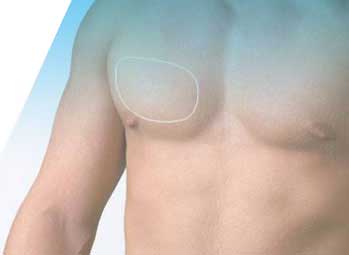Gynecomastia
Gynecomastia is the increased volume of one or both men breasts because of fat accumulation or excessive mammary gland tissue development. May be related to the ingestion of certain substances (such as alcohol, hormones), and some diseases. In some cases we can find a genetic predisposition but in most cases the origin is unknown. Nowadays, this problem effects between 40 and 60% of men in adulthood.
The treatment consists to remove the excess fat and glandular tissue from the breasts, to obtain a flat, firm and well contoured chest.

Indications
Multiple motivations lead a man to consider surgery to improve the image of his torso.
Among them can be enhancement:
• Men who are not satisfied with the size or shape of their breasts.
• Resolve an asymmetry.
First Visit
A personal visit is the first step for any man who is thinking about an intervention of gynecomastia.
Dr. Saez will ask about your general health and what your expectations are.
From an individualized evaluation Dr. Saez will explain the technique and the results that can be achieved by surgery.
Procedure
Gynecomastia correction can be performed by liposuction in 80 % of cases. Fat is aspirated and mammary gland is fragmented, if the glandular component is not very important.
The remaining 20 % of cases, those who have a very enlarged mammary gland, a partial removal of the glandular component is performed through an incision in the lower edge of the areola.
• This operation is usually performed under local anaesthesia and sedation on an outpatient basis (in other words, hospitalization is usually not necessary).
• The operation usually lasts 1 hour.

Post-op care
Although each person’s recovery is different, it is common to follow the next steps:
After the operation the usual stay at the clinic is 3 to 4 hours, thereafter the patient can be discharged.
THE FIRST DAY:
• It is advisable to rest with the chest slightly lifted. You should not manipulate the bandage.
DURING THE FIRST WEEK:
• The bandage will be removed after 3 or 4 days, and you will have to wear a special snug compression garment (band jacket thoracic cage).
• You must take moderate rest, especially the arms.
• You can progressively start to work and return to normal activity after 3 or 4 days.
AFTER THE FIRST WEEK:
• Inflammation will gradually decrease.
• The stitches will be removed (although we don’t usually use visible sutures).
AFTER THE FIRST MONTH:
• Inflammation will be reduced and you will start to see the final result more defined.
• You can stop wearing the compression garment.
• You can do more vigorous exercises.
Results
These interventions provide a great improvement in body contouring, giving patients more fulfilment with their new image.
The results achieved are maintained for many years. However, you must remember that your breasts are not immune to the effects of fluctuations in weight or age.
